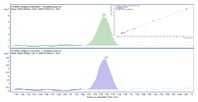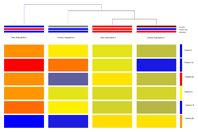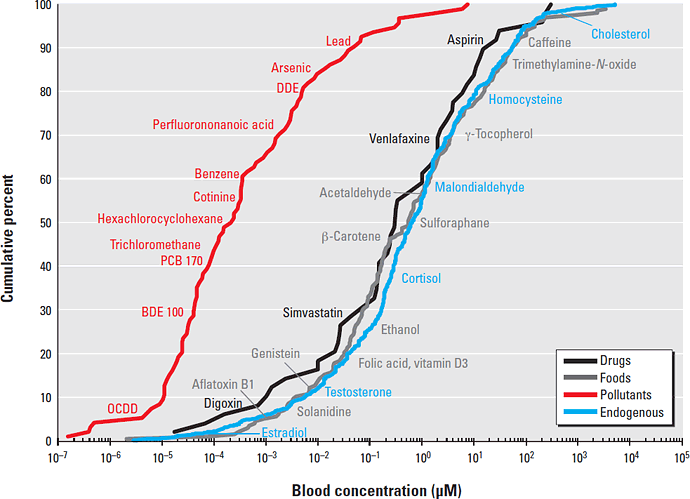Access Agilent eNewsletter August 2015
>> Update My Profile | Subscribe to Access Agilent | Article Directory

Unraveling the exposome: Agilent 7010 Triple Quadrupole GC/MS for integrated biology solutions
By Melissa Churley
Agilent Senior Applications Scientist
and Anthony Macherone
Agilent Senior Applications Scientist and
Visiting Professor, Johns Hopkins University School of Medicine
Two-thirds of global mortality is caused by chronic disease. Of these, respiratory disease, cardiovascular disease, and cancer comprise the majority [1]. In some scientific circles, it is believed that these chronic diseases are the result of genetics and that by sequencing individuals’ genomes (G) one can predict his or her health outcome years in advance [2]. The reality is that more than 1300 genome-wide association studies (GWAS) seldom report risk association greater than 1.2 for prominent single-nucleotide polymorphisms (SNPs). Accordingly, the genetic heritability of chronic disease is relatively low – about 10% to 20% [3].
 Enlarge
Enlarge
Figure 1. Blood concentrations of common exposure compounds. Reproduced from Environmental Health Perspectives.
Daily exposures now linked to a majority of chronic diseases
Although genes are solely responsible for certain chronic diseases, that number is modest. Increasingly, scientists are coming to the realization that exposures encountered in everyday life are at the heart of as much as 90% of complex, chronic disease. Exposures are chemicals that we encounter in the foods we eat, the drugs we take, pollution from our external environment, and our internal chemistry, including the activity of the microbiota in our gut (Figure 1). The exposome (E) has been defined as the lifetime sum of these exposures [4]. In this paradigm, the risk of succumbing to chronic disease is primarily linked to E or some combination of GxE, including epigenetics. Discovery-based and targeted mass spectrometry is used in both the liquid and gas phases to measure E in a comprehensive manner. ICP-MS should also be included for metals exposure.
In the case of persistent organic pollutants (POPs) circulating in blood, targeted GC-MS/MS is highly suited to detect compounds at concentrations as low as 5.0 pg/mL (5 ppt), in sample volumes as low as 200 µL plasma. The data from these workflows can then be reduced using Agilent Mass Profiler Professional (MPP) software for statistical and differential analysis to determine significant features in a given population.
 Enlarge
Enlarge
Figure 2. MRM transitions for PCB 118. 5.0 pg/mL serum calibrator S/N > 25. Inset: calibration curve from 5-1000 pg/mL; amount injected is 5-1000 fg.
 Enlarge
Enlarge
Figure 3. Covariate hierarchal clustering identifies clear differences between case and controls within each population based on compound abundance and frequency.
Screening human plasma with next-generation GC/MS/MS
To gain a better understanding, 51 plasma extracts representing unmatched case/controls from two populations were presented blindly for analysis. Targeted GC/MS/MS was performed for 66 POPs (15 polyaromatic hydrocarbons, 12 dioxin-like polychlorinated biphenyls, 11 polybrominated diphenylethers, 18 organochlorine pesticides, 5 dioxins, and 5 furans) using an Agilent 7890B GC coupled to an Agilent 7010 Triple Quadrupole GC/MS equipped with a High Efficiency Source (HES) in EI MRM Mode. The column was an HP-5MS (30 m x 250 µm, 0.25 µm). For each compound, one quantifying MRM and one qualifying MRM were defined. System performance and precision was monitored at three concentration levels. Each extracted sample was injected in triplicate.
In looking at the results, replicate area precision for the 13C12-DDT internal standard averaged ≤ 3% RSD (min = 0.38% RSD; max = 6.79% RSD; n = 153). Retention time precision was ± 0.122 minutes (n = 9,608). These results demonstrated greater coverage of the POPs concentration range with detection limits as low as 5 pg/mL from the 200 µL plasma samples (Figure. 2). Covariate hierarchal clustering differentiated cases and controls based on variables such as compound frequency/abundance and population group (Figure 3).
Detect more compounds with high efficiency GC/MS/MS
The concentration of POPs in human blood is 1000-fold less than that of dietary chemicals, drugs, and, metabolites. Most non-targeted discovery-based analyses using liquid chromatography time-of-flight or Fourier transform mass spectrometry fail to detect approximately 70% of these compounds [5]. In this study, targeted GC/MS/MS demonstrated greater coverage of the POPs concentration range with detection limits as low as 5 pg/mL. Principle component and hierarchal analysis differentiated cases, controls, and reference samples based on frequency, population, and other meta-data, thus paving the way for future experiments designed to validate the relationship between POPs and disease occurrence.
Agilent analytical instruments and software to assess environmental exposures
The causal relationship of exposures and human health is complex. Agilent analytical instruments and software can provide the tools you need for integrated biology solutions. Learn more about how Agilent broad-based solutions make the most of multi-omics to decipher the exposome. You can also download an informative brochure on the Agilent 7010 Triple Quadrupole GC/MS System, which can quantify analytes at levels previously not achieved by any GC/MS.
We gratefully acknowledge Sarah Daniels and Martyn T. Smith at the School of Public Health, University of California Berkely, and from NMS Labs, Alex L. Maggitti and Matthew McMullin, for their contributions to this article.
References
- R. Lozano, et al. “Global and regional mortality from 235 causes of death for 20 age groups in 1990 and 2010: a systematic analysis for the Global Burden of Disease Study”. Lancet, 2012, 380, 2095–2128.
- P. Brodin, V. Jojic, T. Gao, S. Bhattacharya, C.J. Lopez Angel. “Variation in the human immune system is largely driven by non-heritable influences”. Cell, 2015, 160, 37–47.
- S.M. Rappaport, M.T. Smith. “Environment and disease risks”. Science, 2010, 330, 460–461.
- C.P. Wild. “Complementing the genome with an ‘Exposome’: the outstanding challenge of environmental exposure measurement in molecular epidemiology”. Cancer Epidemiol Biomarkers Prev., 2005, 14, 1847–1850.
- S.M. Rappaport, D.K. Barupal, D. Wishart, P. Vineis, A. Scalbert. “The blood exposome and its role in discovering causes of disease”. Environ Health Perspect, 2014, 122(8), 769–774.
For Research Use Only. Not for use in diagnostic procedures.
>> Update My Profile | Subscribe to Access Agilent | Article Directory
Figure 1.

Blood concentrations of common exposure compounds. Reproduced from Environmental Health Perspectives.
Figure 2.

Methods and materials used for this work:
- MassHunter software
- Mass Profiler Professional (MPP) software
- 7693 ALS
- 7890B gas chromatograph
- 7010 triple quadrupole mass spectrometer
- HP-5MS UI column (30 m x 0.25 m x 0.25µm) part number 19091S-433UI
- Ultra-Inert liner (5190-3983)
MRM transitions for PCB 118. 5.0 pg/mL serum calibrator S/N > 25. Inset: calibration curve from 5-1000 pg/mL; amount injected is 5-1000 fg.
